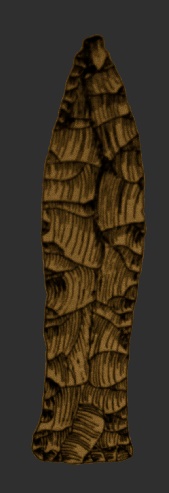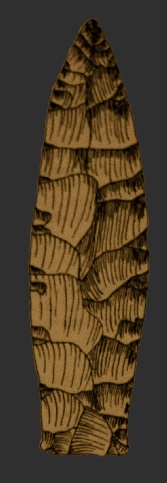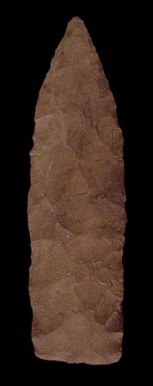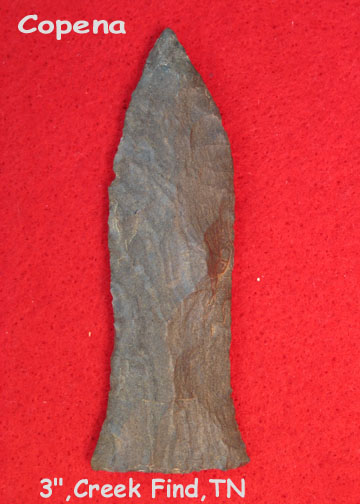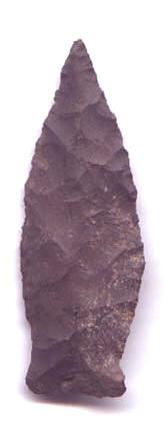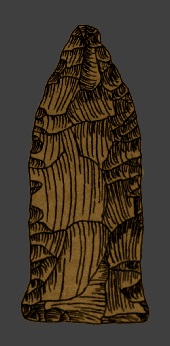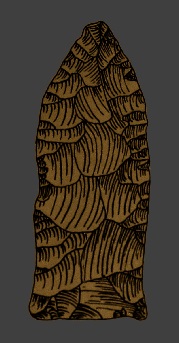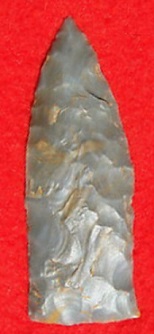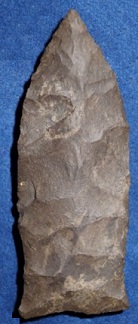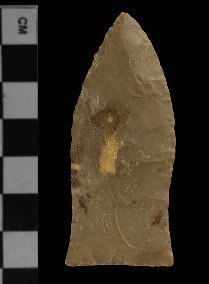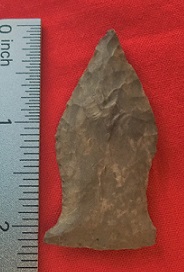Outline is Representative of Size and Shape:
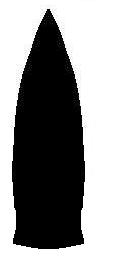
Name Details:
Identified By: William Webb and David DeJannette
Named For: Associated Culture
Date Identified: 1942
Type Site: Pickwick Basin, northern Alabama
Identified By: William Webb and David DeJannette
Named For: Associated Culture
Date Identified: 1942
Type Site: Pickwick Basin, northern Alabama
Point Validity:
Valid type
Webb was a physicist and later anthropologist who developed and headed the Department of Archaeology and Anthropology at the University of Kentucky in 1926. Dejarnette what the first Anthropologist hired by the University of Alabama and was an expert on southeastern archaeology. This point was named in a professional publication and has many professional references. This is considered a valid type.
Webb was a physicist and later anthropologist who developed and headed the Department of Archaeology and Anthropology at the University of Kentucky in 1926. Dejarnette what the first Anthropologist hired by the University of Alabama and was an expert on southeastern archaeology. This point was named in a professional publication and has many professional references. This is considered a valid type.
Copena Lanceolate
Cluster: Copena Cluster Description of Physical Characteristics and Flaking Pattern:
This is a medium to large lanceolate point with an elliptical cross section to a median ridge. The blade is primarily an outward recurvate to an excurvate shape. The hafting region constricts in which causes the recurvate blade shape. The base is primarily straight, but may be slightly convex or concave and may have thinning and light grinding of the hafting region. This point may have a broad shallow random flaking or collateral flaking pattern and the edges are touched up with fine pressure flaking.
Size Measurements:
Total Length - 45 to 130 mm (average 75 mm), Blade Width - 18 to 40 mm, Waist Width - typically 2 to 5 mm narrower than blade, Basal Width - typically 2 to 5 mm wider than the waist, Thickness - 7 to 10 mm
Total Length - 45 to 130 mm (average 75 mm), Blade Width - 18 to 40 mm, Waist Width - typically 2 to 5 mm narrower than blade, Basal Width - typically 2 to 5 mm wider than the waist, Thickness - 7 to 10 mm
Commonly Utilized Material:
Additional Comments:
This culture is primarily associated with northern Alabama. This culture is know for it's burial copper (cop) and galena (ena) artifacts which is where the name was derived from (Copena).
These points represent both utilitarian points and larger ceremonial points (Justice, 1987).
The Ansell points of Illinois and the Gahagan Knives of Texas have the appearance of the Copena points, but are not associated with the Copena Burial culture and are not related to the Copena point (Justice, 1987).
The name Florida Copena was applied by John Whatley (2002) to these points found in Southern Georgia and into Florida. Copena type points found in this area tend to be smaller than Copena type points found north of this point.
This culture is primarily associated with northern Alabama. This culture is know for it's burial copper (cop) and galena (ena) artifacts which is where the name was derived from (Copena).
These points represent both utilitarian points and larger ceremonial points (Justice, 1987).
The Ansell points of Illinois and the Gahagan Knives of Texas have the appearance of the Copena points, but are not associated with the Copena Burial culture and are not related to the Copena point (Justice, 1987).
The name Florida Copena was applied by John Whatley (2002) to these points found in Southern Georgia and into Florida. Copena type points found in this area tend to be smaller than Copena type points found north of this point.
Distribution: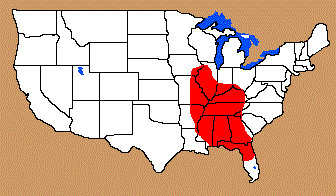
Distribution Comments:
This point is primarily found in the Tennessee River Valley. This point may also be found into the Ohio River Valley, the mid-Mississippi River valley and the Gulf Coast region.
This point is primarily found in the Tennessee River Valley. This point may also be found into the Ohio River Valley, the mid-Mississippi River valley and the Gulf Coast region.
Age / Periods:
Date: 4,000- 1,500 B.P.
Cultural Period: Late Archaic to Early Woodland
Glacial Period: Neoglacial to Roman Warm
Culture: Copper Burial Mound Culture
Date: 4,000- 1,500 B.P.
Cultural Period: Late Archaic to Early Woodland
Glacial Period: Neoglacial to Roman Warm
Culture: Copper Burial Mound Culture
Age Details:
Ledbetter (1992:112) notes layers containing Copena points returned a radiocarbon date of 2,520 ± 24 years B.P. and are found in association with a Coosa Notched point, fabric marked and simple stamped pottery at the Pumpkin Pile site.
Ledbetter (1992:112) notes layers containing Copena points returned a radiocarbon date of 2,520 ± 24 years B.P. and are found in association with a Coosa Notched point, fabric marked and simple stamped pottery at the Pumpkin Pile site.
Other points in this cluster / Related / Associated Points:
Candy Creek, Copena Articulated, Copena Round Base, Copena Triangular, Nolichucky, Greenville
Candy Creek, Copena Articulated, Copena Round Base, Copena Triangular, Nolichucky, Greenville
Pictures:
